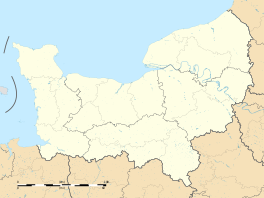Yport
| Yport | ||
|---|---|---|
| Commune | ||

The upstream cliffs
|
||
|
||
| Coordinates: 49°44′19″N 0°18′50″E / 49.7386°N 0.3139°ECoordinates: 49°44′19″N 0°18′50″E / 49.7386°N 0.3139°E | ||
| Country | France | |
| Region | Normandy | |
| Department | Seine-Maritime | |
| Arrondissement | Le Havre | |
| Canton | Fécamp | |
| Intercommunality | CA Fécamp Caux Littoral | |
| Government | ||
| • Mayor (2014-2020) | Alain Charpy | |
| Area1 | 2.07 km2 (0.80 sq mi) | |
| Population (2013)2 | 884 | |
| • Density | 430/km2 (1,100/sq mi) | |
| Time zone | CET (UTC+1) | |
| • Summer (DST) | CEST (UTC+2) | |
| INSEE/Postal code | 76754 /76111 | |
| Elevation | 0–96 m (0–315 ft) (avg. 30 m or 98 ft) |
|
|
1 French Land Register data, which excludes lakes, ponds, glaciers > 1 km² (0.386 sq mi or 247 acres) and river estuaries. 2Population without double counting: residents of multiple communes (e.g., students and military personnel) only counted once. |
||
1 French Land Register data, which excludes lakes, ponds, glaciers > 1 km² (0.386 sq mi or 247 acres) and river estuaries.
Yport is a commune in the Seine-Maritime department in the Normandy region in northern France. The residents are known as Yportais or Yportaises.
Yport is located on the D104 road, about 19 miles (31 km) north of Le Havre, on the coast of the English Channel.
The site was probably occupied during the neolithic period, and later the Pays de Caux was inhabited by the Calates. During the Roman time, a road connecting Fécamp to Étretat passed through the locality at Pitron Fund from where a junction towards the village existed. The current D940 follows the route of this Roman road. The Roman presence was discovered following various archaeological excavations but nothing proves that it was permanently inhabited. It may have been only a fishing site. Starting from the early Middle Ages the village was attached to Criquebeuf-en-Caux, where the church, the cemetery and the school were located, several kilometres away from Yport. Only in the 19th century did the commune of Yport come into existence, primarily because of the construction of the church. Officially, the commune of Yport was created on January 1, 1843 and its first mayor was Jean-Baptiste Feuilloley. The 19th century marked the beginning of the rise of sea-fishing. Many people were attracted to the area by the work and the population reached 1800. The sea front evolved considerably during this period. As a working port, the sea front had fishing-smacks, skiffs, caïques and other vessels moored up to the bollards.
...
Wikipedia



